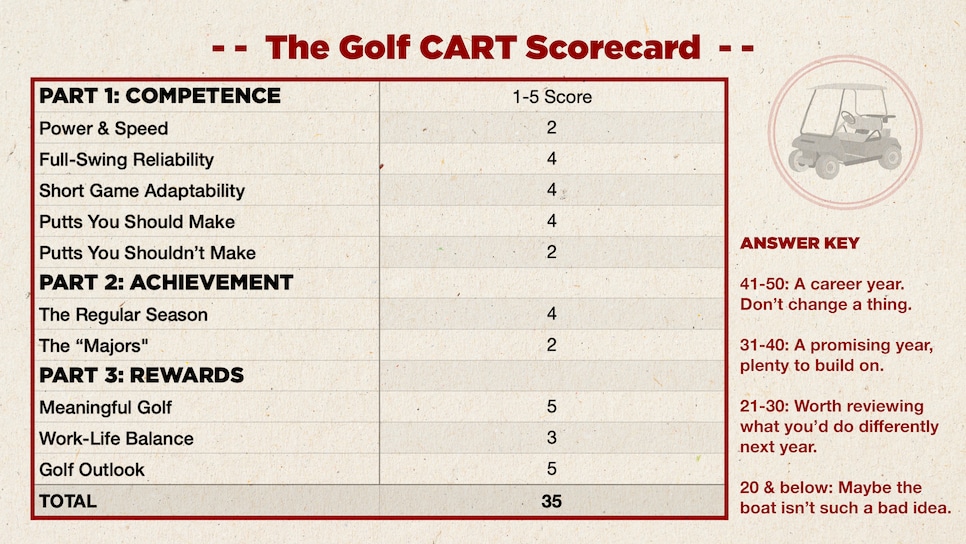I played a decent amount of golf this year, but by one measure it appears I didn’t do much at all. A review of my handicap shows I started the year as an 11 and it looks like I’m ending the year as . . . an 11. It reminds me of that Jerry Seinfeld bit about horses who run frantically around a racetrack, end up back in the same spot, and wonder what the hell the whole thing was for.
A handicap says something about where you are but not enough about where you’ve been, and even there it’s just through a bunch of scores. It’s why I’ve been noodling a self-assessment that puts your entire golf year in proper perspective. I’m calling it the Golf Competence Achievement & Reward Test, otherwise known as the golf CART™—a curious choice for someone who prefers to walk.
How it works
Let’s start by clarifying what we’re looking to achieve. Both the Golf CART™ and the handicap seek to provide a quantifiable answer to different questions. When someone asks, “How good a golfer are you?” my 11 handicap provides an answer. The CART™ is for when you’re asked, “How was your golf season?” It’s a measure of your progress as a player, yes, but also your broader golf experience—how you performed in various areas, how much you enjoyed playing when you did, and even how golf filtered into other parts of your life.
The other big departure from a handicap is that the CART™ is all relative. It’s a measure of your progress based on your standards. There is no real golf category in which I could outperform a PGA Tour player. But it’s likely I was happier with my putting this season than Scottie Scheffler was with his, in part because my family is not relying on my putting to eat.
The scoring system
The system is simple. There are 10 categories in which you grade yourself on a 1-5 scale. A 5 is exceptional for you, 4 is above average, 3 is average, 2 is below average, 1 is absolute crap. Again, the benchmark here is your level, so it helps to compare this year to the one or two years prior.
Not sold? Let’s get to the categories, where I’ll use myself as an example.
More Low Net  Low Net This is why you make dumb decisions at the end of a round
Low Net This is why you make dumb decisions at the end of a round  Low Net It’s something most golfers hate, but it’s actually great for them
Low Net It’s something most golfers hate, but it’s actually great for them  Low Net A History Of Swing Thoughts Part 1: Competence
Low Net A History Of Swing Thoughts Part 1: Competence
The CART™ doesn’t dispute that much of our golf satisfaction is tied to how well we execute in specific areas, but we wanted to probe deeper than the typical ball-striking and putting statistics used elsewhere. All of these questions are meant to assess whether you feel you’ve made tangible progress in areas that influence your golf experience.
1. Power and speed: While this is primarily an assessment of your driving proficiency, it extends elsewhere. Were your good drives leaving you shorter distances into greens? Could you carry ambitious hazards more or less than before? While it’s possible to have ample clubhead speed and not be a good golfer, trust me: a power deficiency tends to seep into your performance and your enjoyment over the balance of a season.
Me: The worst part of my game. Some recent speed training has helped, but overall it’s been a tough year: 2.
2. Full swing reliability: You could measure a swing’s efficacy any number of ways, but a telling gauge is this: How comfortable are you with a 7-iron in your hand, to hit a moderate-sized target? We’re not talking about attacking pins, but compared to the year prior, do you feel better about that shot, worse, or about the same?
Me: I feel like I’ve made progress in this area, so I’ll give myself a 4.
3. Short game versatility: A good short game is about much more than your ability to hit a standard chip, but your adaptability in certain situations—tight lies, heavy rough, a bunker shot over a high lip. Another way to frame it: You miss a green and are not sure what sort of shot you will face as you approach your ball. How big is the pit in your stomach?
Me: I have more confidence in this area than I probably should—4.

4. Putts you shouldn’t make: Not dissimilar from speed or lag putting, this mainly reflects your ability to leave yourself gimmes or even hole a few from significant distances. By the way, if you’re wondering what counts as a putt you shouldn’t make, check out our How Do You Compare? interactive. The answer is basically everything.
Me: The less expected of me, the better I am—4.
5. Putts you should make: A pretty simple way to think about this: You lag your first putt to three feet. Do you welcome the chance to sink the next one, or are you praying your opponent says it’s good? Fair or not, the shortest shots risk sticking with you the longest.
Me: While not terrible, my short putting was a notch below my long putting—2.
Part 2: Achievement
A conceit for all the golf we play at this level is that the stakes are fairly low. But even there, I believe our golf can be divided into two categories—our regular rounds, and the “big” ones.
6. The Regular Season (aka ‘The Joe’ Scale’): I play a pretty standard game with the same group of guys, one of whom is my rival/neighbor/friend/tormentor Joe. Joe is nothing if not a decent benchmark for the state of my own game, hence why I’m unofficially referring to this as ‘The Joe Scale’. Broadly, the question is how you fared in what you considered “regular rounds.” Was your best golf better, and your worst golf less awful? Did you flirt with any benchmark rounds, or did you regress? Did you beat your version of Joe more than you lost to him?
Me: Joe will claim I drafted off superior playing partners, but I generally finished ahead this year—4.
7. The Majors: In a Low Net world, the majors are those rounds where you at least make sure you have enough tees and balls without scuff marks in your bag: club championships, member-guests, buddies trips with a pre-arranged format. These are the rounds that “matter” the most, which means they’re still insignificant, but we obsess about them anyway.
Me: I never made it past the second round in any of the match-play tournaments I entered and finished dead last in a buddies trip tournament I organized. That I pulled some shop credit in a few one-day events is what stopped it short of complete disappointment—2.
Part 3: Rewards
While you might think rewards and achievement are similar, they’re actually not. One of the Low Net principles is that golf is sometimes fun, but always rewarding in how it teaches us about ourselves, and presents new challenges. So here, the rewards are the extent that golf shaped you this year, the outlet it provided, and the connections and memories it forged.
8. Meaningful golf: The first part of this is simple: Did you play enough golf? Or did life get in the way? But it’s also about the quality of golf you played, because I’d argue your meaningful golf quotient should depend heavily on your ability to extract value from a wide assortment of occasions—from bucket list trips to six-round loops at dusk. The best golf years create the bold-faced memories, but also a sufficient number of delightful little moments in between.
Me: An incredible year for me on this front, perhaps best encapsulated a Friday evening fivesome featuring my older brother, my two sons, and my 88-year-old dad—5
9. Work-Life Realities (aka ‘The Divorce/Unemployment Scale’): The counterbalance to playing enough meaningful golf is something else could be suffering. Did golf lead to unrest at home? Did you blow off too much work? The CART™ contends that a great golf year should not come at too great an expense of other aspects of life. Welcome scenario: The golf you play is time well spent, which alleviates the stress from work, which allows you to be more present with your family. Another scenario: You played a lot of golf, but no one really seemed to notice. This is the toughest one to gauge, and frankly hinges on more than just you.
Me: Here is one area where my position at Golf Digest probably warps the equation, since even my wife recognizes playing golf is at least a small part of my job (playing golf well is another matter). But I don’t get it perfect, either, which you’d agree with if you saw the state of my lawn—3.
10. Golf outlook: The nature of your golf season is going to linger even after you stop playing (although I make an argument here why you should keep going). Put simply: What was your golf mood this year? While frustration is inevitable, did you still walk away excited about your golf future? Are you looking forward to building on a successful foundation this offseason, or at least motivated to address what held you back? Do you mostly welcome a break? At any point recently have you looked into buying a boat?
Me: My level of golf optimism borders on delusion—5.
Answer Key 
41-50: A career year. Don’t change a thing.
31-40: A promising year, plenty to build on.
21-30: Worth reviewing what you’d do differently next year.
20 & below: Maybe the boat isn’t such a bad idea.
Me: I clocked in at 35. No golfer is ever satisfied, and that’s certainly true when I review specific aspects of my game. But my premise was confirmed: for a year in which I made no tangible progress, it was still pretty damn good.
This article was originally published on golfdigest.com



